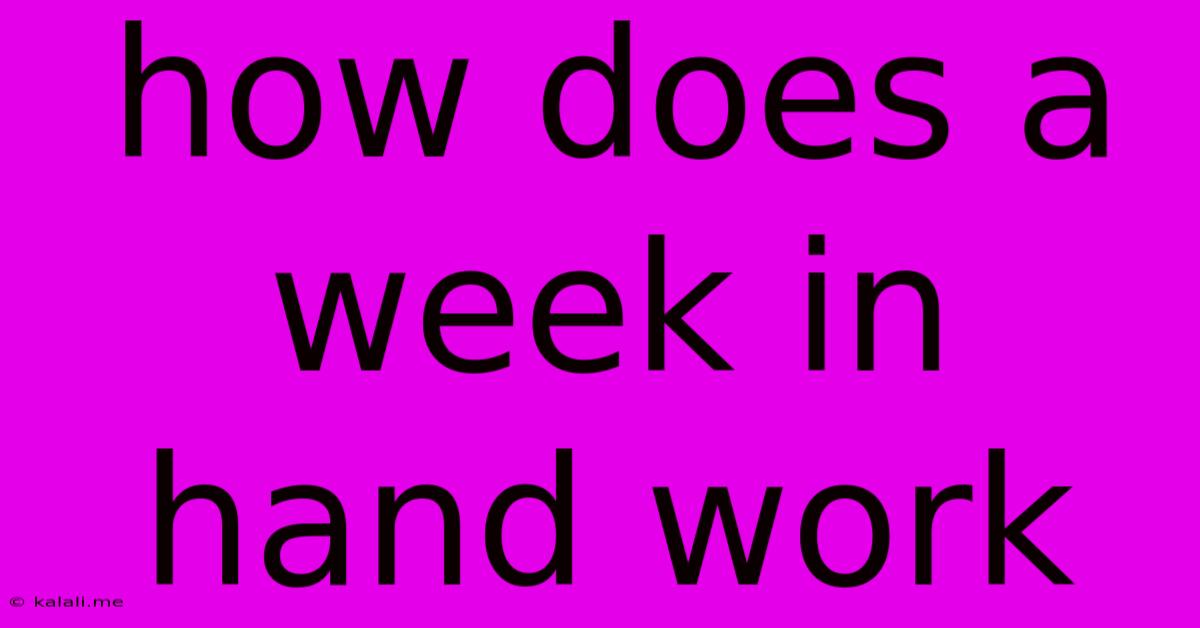How Does A Week In Hand Work
Kalali
May 21, 2025 · 3 min read

Table of Contents
How Does a Week in Hand Work? Understanding the Agile Planning Method
This article explains the "week in hand" agile planning method, a powerful technique for managing sprints and predicting project completion. We'll delve into its mechanics, benefits, and potential drawbacks. Understanding this method can significantly improve your project management efficiency.
A "week in hand" (often shortened to "WiH") isn't a formal agile methodology like Scrum or Kanban, but rather a practical planning strategy often used within those frameworks. It focuses on maintaining a buffer of completed work, representing a week's worth of development, ahead of the current sprint's schedule. This buffer acts as a safety net against unexpected delays and allows for more accurate sprint forecasting.
How the Week in Hand Strategy Works
The core principle is simple: before starting a new sprint, your team should have a week's worth of tasks already completed and ready to deploy. This "hand" of completed work provides several advantages:
- Reduced Risk of Slippage: Unexpected issues, bugs, or technical challenges are inevitable in software development. A WiH acts as a cushion, absorbing these unforeseen delays without immediately impacting the sprint's planned delivery.
- Improved Sprint Velocity Prediction: By consistently maintaining a WiH, you gain a better understanding of your team's true velocity. This improves the accuracy of sprint planning and prevents over-committing during future sprints.
- Increased Confidence in Delivery: Knowing you have a safety net reduces anxiety and improves team morale. The predictability offered by WiH fosters a more positive and productive working environment.
- Enhanced Flexibility: If a high-priority task emerges unexpectedly, the WiH allows for more flexible prioritization without compromising the sprint goal. The completed tasks can be deployed while the team focuses on the new priority.
- Better Risk Management: Regularly reviewing and managing the WiH allows for proactive identification and mitigation of potential risks within the project.
Implementing a Week in Hand: Practical Steps
Implementing a WiH requires careful planning and execution. Here's a step-by-step guide:
- Establish a Consistent Sprint Cycle: Choose a fixed sprint length (e.g., two weeks) to maintain rhythm and predictability.
- Prioritize Tasks Strategically: Ensure tasks are prioritized based on dependencies and business value. Focus on completing high-value items for the WiH.
- Accurate Task Estimation: Use a consistent estimation technique (e.g., story points) to accurately gauge the effort required for each task.
- Monitor Progress Regularly: Regular daily or weekly stand-up meetings are vital to track progress and identify potential roadblocks early.
- Maintain a "Done" Definition: Establish clear criteria for what constitutes a "completed" task to avoid ambiguity and maintain the integrity of the WiH.
- Adapt and Iterate: The WiH is a tool, and its effectiveness depends on your team's context and processes. Be prepared to adjust the approach as needed.
Potential Challenges and Considerations
While beneficial, the WiH approach also presents some potential challenges:
- Initial Overhead: Building the initial WiH might require extra effort upfront.
- Maintaining Consistency: Requires consistent discipline from the development team.
- Not Suitable for All Projects: The approach might not be ideal for projects with rapidly changing requirements or very short sprints.
In conclusion, a week in hand is a valuable technique for enhancing agile project management. By strategically managing a buffer of completed work, teams can improve predictability, mitigate risk, and boost overall efficiency. However, successful implementation requires careful planning, consistent effort, and a willingness to adapt the strategy to the specific needs of the project and team. Remember to carefully consider the potential challenges before adopting this approach.
Latest Posts
Latest Posts
-
What Is Semi Sweet Chocolate In Uk
May 21, 2025
-
Boiler Loses Pressure When Heating Is Off
May 21, 2025
-
How To Stop Moisture Coming Through Concrete Floor
May 21, 2025
-
Why Is The Paint Peeling Off The Wall
May 21, 2025
-
Calories In A Cup Of Uncooked Rice
May 21, 2025
Related Post
Thank you for visiting our website which covers about How Does A Week In Hand Work . We hope the information provided has been useful to you. Feel free to contact us if you have any questions or need further assistance. See you next time and don't miss to bookmark.